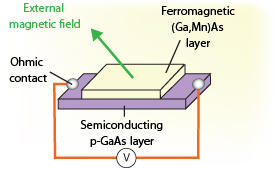

08/26/2013

Reproduced from Ref. 1 © 2013 L. Chen et al.
The field of spintronics relies on exploiting the spin of the electron in the same way that electronics is dependent on the electron’s charge. Spintronics holds exciting promise for the generation of ever smaller devices, and an important step in their realization is the introduction of spin current to non-magnetic materials.
In solids, the spin and momentum of an electron are coupled, leading to a reciprocal conversion between charge and spin currents that can be described by a phenomenon known as the spin Hall effect. Whereas the ‘direct spin Hall effect’ converts current into an accumulation of spins, the ‘inverse spin Hall effect’ converts spin flow into charge current. Interestingly, both effects have been observed in metals and semiconductors.
The inverse spin Hall effect is often determined through the measurement of spin currents. Through a quantitative study, Lin Chen, Fumihiro Matsukura and Hideo Ohno from the AIMR at Tohoku University have now unambiguously shown that other — galvanomagnetic — effects must be taken into account when investigating spin currents1.
Galvanomagnetic effects are observed when an external magnetic field is applied to a current-carrying conductor or semiconductor material. To demonstrate their presence, Chen, Matsukura and Ohno prepared a sample comprising a ferromagnetic layer, gallium manganese arsenide ((Ga,Mn)As), on a semiconducting substrate, gallium arsenide (p-GaAs).
The researchers generated a spin current in the (Ga,Mn)As and injected it into the p-GaAs layer using a method known as ‘spin pumping’. They then measured the resulting direct-current voltage in the p-GaAs layer. The study was carried out under ferromagnetic resonance (FMR) conditions, allowing the magnetization of the ferromagnetic layer to be characterized by FMR spectroscopy. In particular, the team examined the influences of the magnitude and angle of the external magnetic field.
Analysis of the results revealed that the expected inverse spin Hall effect was accompanied by a galvanomagnetic phenomenon — the ‘planar Hall effect’ — in the ferromagnetic (Ga,Mn)As layer. “It is especially difficult to distinguish the inverse spin Hall effect from the planar Hall effect, as they both produce lines of the same symmetry and width in FMR spectra. The difference lies in the angular dependence,” explain the researchers. “These findings indicate the critical importance of separating the origins of the direct-current voltage.”
The next step will be to show that this strategy is not just applicable to materials like (Ga,Mn)As that demonstrate significant galvanomagnetic effects. “This method should help further our understanding of the physics of spin current and the development of new functional spintronic devices,” says Matsukura.
Chen, L., Matsukura, F. & Ohno, H. Direct-current voltages in (Ga,Mn)As structures induced by ferromagnetic resonance. Nature Communications 4, 2055 (2013). | article
This research highlight has been approved by the authors of the original article and all information and data contained within has been provided by said authors.